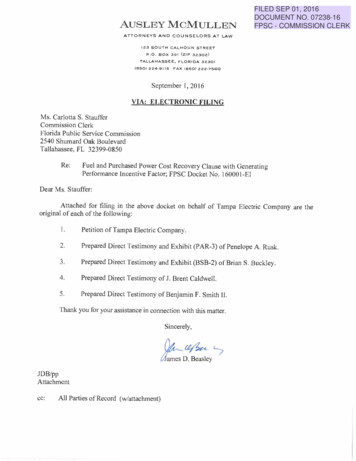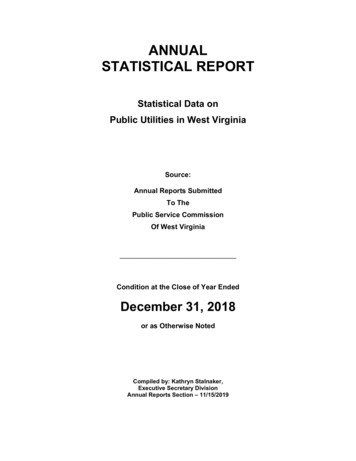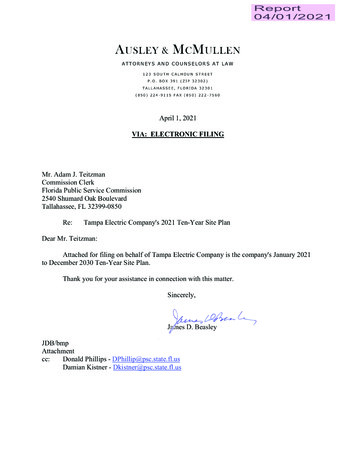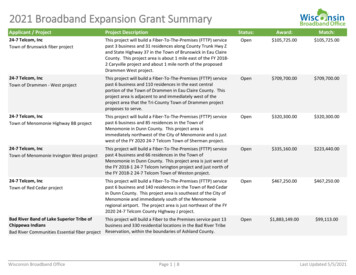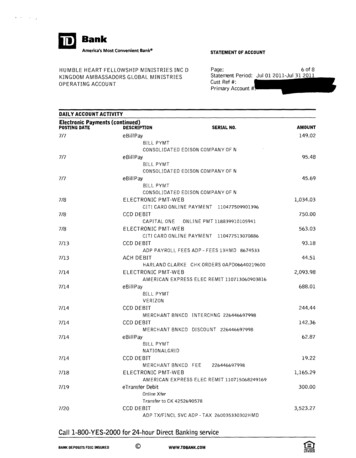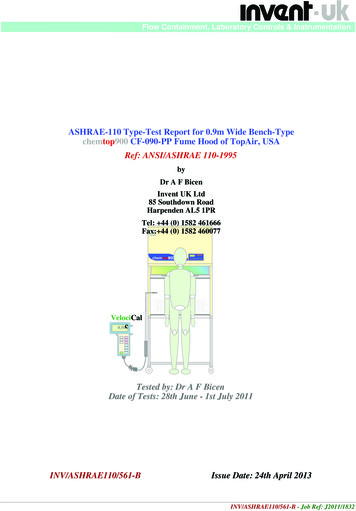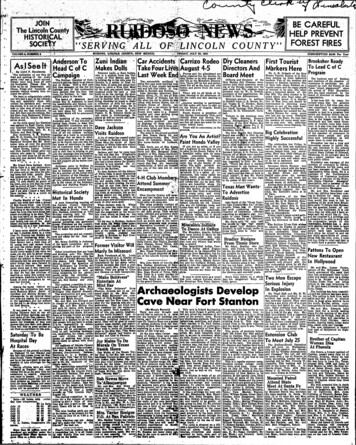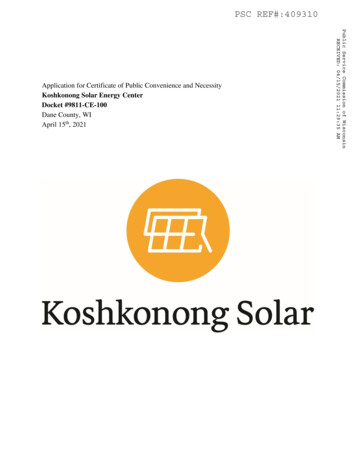
Transcription
PSC REF#:409310Public Service Commission of WisconsinRECEIVED: 04/15/2021 11:29:35 AMApplication for Certificate of Public Convenience and NecessityKoshkonong Solar Energy CenterDocket #9811-CE-100Dane County, WIApril 15th, 2021
Table of Contents1.2.3.4.Project Description and Overview .11.1General Project Location and Description of Project and Project Area .11.2Ownership .41.3Project Need/Purpose .51.4Alternatives.71.5Utilities (CPCN OR CA) and IPPs (CPCN) – Site Selection .131.6Utilities Only – Cost .181.7IPPs Only – MISO and Project Life Span .191.8Utilities and IPPs – Required Permits and Approvals .22Technical Description – Project Area, Arrays, Panels, and Ancillary Facilities .292.1Estimated Solar Resource and Projected Energy Production .292.2Solar Panel Type and Characteristics .302.3Other Project Facilities .352.4Substation .432.5Transmission and Distribution Interconnection .452.6Operations and Maintenance (O&M) Building.482.7Battery Storage .50Construction Sequence and Workforce .533.1Construction Sequence .533.2Workforce .553.3Construction Equipment and Delivery Vehicles .55Project Maps, Aerial Photography, Photo Simulations, and GIS Shapefiles .594.1Project Area Maps.594.2 GIS shapefiles – Provide GIS shapefiles and attributes as listed below. GIS attributetable information should be clearly labeled to identify fields and feature names. .624.3 Topography ‒ Raster files of topographic features within the project area andsurrounding landscape (10-mile radius of the project area). .654.45.Photo Simulations .65Natural and Community Resources, Description and Potential Impacts .655.1Site Geology .655.2Topography .67i
5.3Land Cover .685.4Invasive Species .815.5Vegetation Management .825.6Wildlife .835.7Public Lands .955.8Contaminated Sites .975.9Local Zoning and Safety .995.10Land Use Plans .1035.11Archaeological and Historic Resources.1035.12ER Review ‒ Endangered, Threatened, and Special Concern Species andCommunities .1056.7.8.5.13Agricultural Impacts .1065.14Airports and Landing Strips .1115.15Communications Towers .1145.16Electric and Magnetic Fields (EMF) .1175.17Noise .1185.18Solar Panel Glint or Glare.119Local Government Impacts.1226.1Joint Development and Other Agreements .1226.2Infrastructure and Service Improvements .124Landowners Affected and Public Outreach .1257.1Contact lists .1257.2Public Outreach and Communication .125Waterway/Wetland Permitting Activities .1308.1Waterway Permitting Activities .1308.2Wetland Permitting Activities.1388.3Mapping Wetland and Waterway Crossings .1458.4Erosion Control and Storm Water Management Plans .1478.5Materials Management Plan .1538.6Dewatering Plans .157ii
TABLESTable 1.4.2 – Brownfields Sites in Southern Wisconsin CountiesTable 1.5.3.1 – Koshkonong Solar Setback MatrixTable 1.5.3.3 – Landowner Easement Type and StatusTable 1.8.1 – Regulatory Permits and ApprovalsTable 1.8.2 – Correspondence with Permitting AgenciesTable 5.3.2.4 – Estimated Land Cover Type Within Project AreaTable 5.3.3.1 – Array Area Land Cover ImpactsTable 5.3.3.2 – Collection System Land Cover ImpactsTable 5.3.3.3 – Access Road Land Cover ImpactsTable 5.3.3.4 – Substation and BESS Land Cover ImpactsTable 5.3.3.5 – O&M Building Land Cover ImpactsTable 5.3.3.6 – Generator Tie Line Land Cover ImpactsTable 5.3.3.6a – Laydown Yard Temporary Land Cover ImpactsTable 5.8.1a – BRRTS Listings Within the Project AreaTable 5.8.1b – BRRTS Listings within the 2-Mile BufferTable 5.8.2 – Environmental Repair and Solid Waste Listings Within 2-miles of the Project AreaTable 5.14.1 – Airports and Landing StripsTable 8.4.2a. – Existing and Proposed Infiltration Rates for the Project AreaTable 8.4.2b – 1-year & 2-year Runoff Rate SummaryTable 8.4.2c. – 10-year & 100-year Runoff Rate SummaryTable 8.4.2d. – TSS RemovalFIGURESFigure 1.1.2 Project VicinityFigure 4.1.1 General Project Area MapFigure 4.1.2 Detailed Project Area MapsFigure 4.1.3 Topographic MapsFigure 4.1.4/4.1.5 Substation, POI, O&M Area, Battery Storage, and Laydown YardFigure 4.1.4/4.1.5 O&M Building DiagramFigure 4.1.6.1 Wetlands and WaterwaysFigure 4.1.6.2 Land OwnershipFigure 4.1.6.3 Public LandsFigure 4.1.6.4 Land CoverFigure 4.1.6.5 Flood Insurance RatesFigure 4.1.6.6 Soils SurveyFigure 4.1.6.7A Depth To BedrockFigure 4.1.6.7B Bedrock Geologic MapFigure 4.1.7.1 ZoningFigure 4.1.7.3 AirportsFigure 4.1.8.1 Communications InfrastructureFigure 5.12 DNR ER Review (CONFIDENTIAL-Appendix K)iii
Figure 8.3.1 Wetland and Waterway Crossings – Topographic MapFigure 8.3.2 Wetland and Waterway Crossings – Air PhotoFigure 8.3.3 Wetland and Waterway Delineation Method Map SetFigure 8.5.1 Haul RoutesAPPENDICESAppendix A Correspondence with Permitting AgenciesAppendix B MapsAppendix C Equipment DatasheetsAppendix D Typical Construction DetailsAppendix E Photo SimulationsAppendix F Site Characterization StudyAppendix G Health and Safety Impacts StudyAppendix H ScheduleAppendix I Local Land Use PlansAppendix J Cultural Resources Review [CONFIDENTIAL]Appendix K ER review [CONFIDENTIAL]Appendix L Erosion Control and Stormwater Management PlanAppendix M Economic Impact StudyAppendix N EMF StudyAppendix O Line of Sight and Broadcast CommunicationsAppendix P Noise StudyAppendix Q Glare StudyAppendix R Mailing ListAppendix S Public OutreachAppendix T Geotechnical Engineering ReportAppendix U DNR Data Tables, Navigability Determination Requests, Wetland DelineationReportAppendix V Shapefiles and Electronic Files (Submitted via disk to PSC)Appendix W Vegetation Management StrategyAppendix X Preliminary Drainage StudyAppendix Y PVSyst Output Report [CONFIDENTIAL]Appendix Z Sample Participation Easement AgreementAppendix AA Market Impact AnalysisAppendix AB Emissions AnalysisAppendix AC MISO DocumentsAppendix AD Local Agreementiv
RGISGSUHDDHSGHzIBAIPaCISODEFINITIONSAlternating CurrentApplication Filing RequirementsAsset Purchase AgreementArea of Special Natural Resource InterestAmerican Transmission CompanyAmerican Wire GaugeBelow Ground SurfaceBest Management PracticeCertificates of AuthorityConstruction General PermitLean ClayCertificate of Public Convenience and NecessityClean Power ResearchConservation Reserve ProgramDepartment of Agriculture, Trade and Consumer ProtectionA-weighted decibelsDirect CurrentDigital Elevation ModelDepartment of Natural ResourcesDepartment of TransportationErosion Control and Stormwater Management PlanElectromagnetic FieldElectromagnetic InterferenceEndangered ResourceEndangered Resource ReviewFederal Aviation AdministrationFederal Emergency Management AgencyFederal Regulation (Code of Federal Regulations reference)Geographic Information SystemGenerator Step-up TransformerHorizontal Direction DrillingHydrologic Soil GroupHertzImportant Bird AreaInformation for Planning and ConsultationInternational Standards Organizationv
ADNHDJoint Development AgreementThousand Circular Mils (Wire Gauge Measurement)Observation PointKilovoltKilowattKilowatt-hourLow Impact DevelopmentLimited Liability CorporationManaged Forest LawMegahertzMidcontinent Independent System OperatorMegawattsNational Agriculture Imagery ProgramNational Electrical CodeNational Electrical Safety CodeNext-Generation RadarNational Hydrography DatasetNNWRNPDESNRISNWIO&MOTA TVPSCpsfPVRECROWNecedah National Wildlife RefugeNational Pollutant Discharge Elimination SystemNetwork Resource Interconnection ServiceNational Wetland Inventory MappingOperations and MaintenanceOver-The-Air TelevisionPublic Service CommissionPounds per square footPhotovoltaicRenewable Energy CertificateRight of WaySCADASCSSERSHPOSNASPSPCCSupervisory Control and Data AcquisitionSite Characterization StudySocio-Economic ReviewState Historic Preservation OfficeState-Designated or Dedicated Natural AreaPoorly-graded SandSpill Prevention, Control, and Countermeasuresvi
SPTSSURGOTMYUSUSACEUSCSUSFWSUSGSUWM CRMVMSWWDNRWGNHSWHSWisDOTWPDESWWIStandard Penetration TestSoil Survey Geographic DatabaseTypical Meteorological YearUnited StatesUnited States Army Corps of EngineersUnified Soil Classification SystemUnited States Fish and Wildlife ServiceUnited States Geological SurveyUniversity of Wisconsin-Milwaukee Cultural ResourcesManagementVegetation Management StrategyWattsWisconsin Department of Natural ResourcesWisconsin Geological and Natural History SurveyWisconsin Historical SocietyWisconsin Department of TransportationWisconsin Pollutant Discharge Elimination SystemWisconsin Wetland Inventory Mappingvii
1. Project Description and Overview1.1 General Project Location and Description of Project and Project Area(The overall size of the project area will have an impact on the amount of data and analysesrequired in this AFR. It is recommended that the project area be optimized so that theproject retains flexibility for siting panels while at the same time reducing the total area forwhich data will be required.)1.1.1 Provide the following information about the project:1.1.1.1 Project location ‒ county and townships in the project area.The Project is located in the Towns of Christiana and Deerfield, Dane County. TheProject Area is north and east of I-90 and intersected by Highway 12/18 and west ofthe Dane-Jefferson County Line. The Project covers Sections 1-4, 8-12, 14-17, 20-23,26-27, and 33-34, Township 6N (Christiana Township), Range 12E in Dane Countyand Sections 35-36, Township 7N (Deerfield Township), Range 12E in Dane County(Appendix B, Figure 1.1.2).1.1.1.2 Size of project area (in acres) and size of solar arrays (in acres)The Project will be built within a 6,384-acre Project Area. Within the Project Area,Koshkonong Solar has approximately 4,600 acres under contract. Of the 4,600 acresunder contract, 2,349 acres are proposed as Primary Array areas, and represent theapproximate acreage anticipated to be required to host 300 MW of solar generatingfacilities. This area would include the surface area of solar panels themselves, spacingbetween the racking system, fence line, and access roads. The approximately 4,600acres under contract represents all of the land that would be required to accommodatethe solar panels for the 300 MW capacity plus 43 percent more land for panel siting,described as Alternative Array areas. The Alternative Array areas comprise enoughland to accommodate 43 percent additional capacity, presenting Primary andAlternative Array areas that are capable of hosting a gross capacity total of 429MW. The panel siting layout is shown in Figures 4.1.1 and 4.1.2 (Appendix B).If all areas presented in the layout are deemed acceptable by the Commission for useby the Project, it may be beneficial to design the final 300 MW Project layout to usemore than the 2,349 acres stated above for the following reasons:1) Ample availability of constructible surface area allows for the most efficientProject layout. For example, adjusting spacing of aisles to avoid shading from onerow to the next will ensure the highest performance of the tracking system and ahigher capacity factor, which results in more energy production on a per megawattinstalled basis.2) A higher level of approved area affords the Project the ability to increase setbacksfrom fences, trees, roads, houses and other features, or to adjust the layout tominimize impacts to wetlands or other areas of environmental concern.1
3) As covered in more detail in Section 1.4 of this application, the proposed layoutincludes uniform power blocks wherever possible to reduce cost and otherimpacts. More acceptable and approved area increases the number of uniform arraysthat could be constructed.Of the approximately 4,600 acres under contract by the Project within the ProjectArea, Koshkonong Solar expects that approximately 15 acres will be purchased andutilized for collection routing, site access, the Project Substation, and an operationsand maintenance (“O&M”) building. Additionally, Koshkonong Solar expects topurchase approximately 25 acres to be utilized for the battery energy storage system(“BESS”).1.1.1.3 Size (rated capacity), in both DC and alternating current (AC) MWs, ofthe proposed project. (If an actual panel model is not yet under contract,the applicant must provide information on at least two models that arebeing considered. Those panels must represent the maximum andminimum megawatt size under consideration for purchase for the project.The Project will have an installed capacity of up to 300 MWac. Power is generated bythe panels as direct current. This direct current is then converted to alternating currentby inverters. Total power production by the panels may be up to 387 MWdc (directcurrent).PV panels (also referred to as solar modules) produced by several manufacturers areunder consideration for the Project, including Canadian Solar, Hanwha Qcells, JASolar, Jinko, Longi, Risen, SunPower, and Trina. The Project will analyze currentmarket offerings to make a final selection on specific solar module, inverter andracking system equipment. An example configuration that is representative of whatwould be used consists of 566,037 to 730,188 high-efficiency solar PV panels with acapacity to generate approximately 350-600 watts (W) of DC power each.Examples of specific panel models in this range are the Longi LR6-72HBD on thelow wattage end and the Jinko Eagle 72HM on the higher wattage end. While thesetwo models are typical examples of what may be installed, final engineering willutilize the best, most economical technology available, which may include higherwattage modules. It is also possible that a different manufacturer of a substantiallysimilar product could be selected in final procurement. Examples of different modulesand outputs can be found in Appendix C.The marketplace for solar modules is constantly changing. Although the descriptionabove is representative of a likely choice for equipment, panels could exceed 600 WDC power output each, potentially leading to fewer total panels or other selectedmanufacturers. If the final selected panel is rated higher than 600 W DC, Koshkonong2
Solar will notify PSC staff of this selection and provide updated estimates of theinformation provided above.1.1.1.4 Number of panel sites proposed for the project and the number ofalternate panel sites that have been identified (See the discussion on page1 regarding alternatives).The Primary plus Alternate Array layout has been divided into 33 fence boundaryareas for identification and discussion purposes as shown in Figures 4.1.1 and 4.1.2(Appendix B). The Typical Power Block Configuration in Appendix D illustrateshow the Project could be divided into approximately 145 power blocks utilizing 4.2MW inverters for representative purposes. Of the 145 power blocks, 89 wouldcomprise Primary Array areas and 56 would comprise Alternate Array areas.1.1.1.5 Identify any new or modified electric transmission lines or other electrictransmission facilities that might be needed.Information regarding new or modified electric transmission lines or other electrictransmission facilities is described in Appendix AC. This includes the facilitiesdetermined necessary by Midcontinent Indepen
Application for Certificate of Public Convenience and Necessity Koshkonong Solar Energy Center Docket #9811-CE-100 Dane County, WI April 15th, 2021 PSC REF#:409310 Public Service
